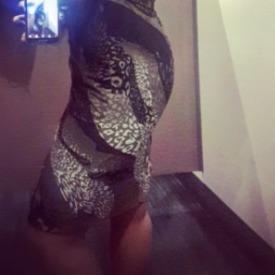Women and squats

wonderwoman234
Posts: 551 Member
I have just started doing squats using a 45 lb. barbell. Man, they are hard! Has anyone else struggled to get down low enough? In another week I'll start adding weight to the bar.
I know I am getting a great workout because all of the machines I was using (leg press, butt blaster, leg extension, hamstring curl, etc.) didn't create the burn I have in my lower half just doing squats.
I tried using a wider stance (Sumo?) to try to reach parallel....not sure I'm quite there yet.
Any tips to get down where I need to be would be welcome!
I know I am getting a great workout because all of the machines I was using (leg press, butt blaster, leg extension, hamstring curl, etc.) didn't create the burn I have in my lower half just doing squats.
I tried using a wider stance (Sumo?) to try to reach parallel....not sure I'm quite there yet.
Any tips to get down where I need to be would be welcome!
0
Replies
-
best way to give advice is for you to post a video of your form. it could be leg spacing, hip mobility, or bunch of other things.0
-
Hmmm, I guess I could ask someone at the gym to film me gettin' low. Bow chicka bow wow......(just kidding.....)
I suspect it is hip mobility. My left hip is sore almost all the time - feels like the cartilege/connective tissue. I stretch for a good 20 mins after every workout but it doesn't seem to help.0 -
I found getting used to the full range of motion was really helpful. Find some furniture that is the right height for you (it should be the height that gets you just below parallel). Just squat until you touch that. Learn what it feels like and be consistent with that before you add any more weight.0
-
My physiotherapist had me doing squats holding onto a door frame. Face the frame.. hold on and drop your butt. Don't use your arms to pull yourself back up... engage your butt... but that will help you practice getting low.0
-
You might just have to work up to it and build at the right muscles--especially core muscles and muscles in and surrounding the knees--not just hams and quads.0
-
Ya gotta stick that butt out gurl! - seriously though, stick it out to the point you feel ridiculous. Once I start feeling utterly stupid I know I'm in the right place!0
-
My physiotherapist had me doing squats holding onto a door frame. Face the frame.. hold on and drop your butt. Don't use your arms to pull yourself back up... engage your butt... but that will help you practice getting low.
I will try this tomorrow. My legs are DEAD today from doing squats.....in a good way?! 0
0 -
Butt out - got it!0
-
Toes slightly outward... feet slightly wider than shoulder width apart... sit into the lift. Keep your weight on the heels of your feet (even raise your toes if you have to) and keep your back as straight as possible. A lot of people try to fold up like a jackknife.
* Former competitive lifter.0 -
Increasing your hip and ankle mobility will help a lot. You can find lots of really good videos on YouTube. I recommend Kelly Starrett's Mobility WOD series.
Also doing more squats will make you more flexible. Just keep feeding the beast and it will come. Have some one watch you to give you feedback on your form.0 -
Keep up with them! I've been doing them regularly for 3 months now and the change is crazy awesome!0
-
You need to stretch. Youtube has Elliot Hulse. The videos are kind of annoying, but he has great advice.
 https://www.youtube.com/watch?v=C-0Qe80fUaU
https://www.youtube.com/watch?v=C-0Qe80fUaU
Mark Rippetoe also has great advice.
Getting low takes time, and it one of the best, if not THE best reason to take it slow with the weight increases. Learn to get low first, then up the weights. There's no rush.0 -
Butt out, knees tracking over feet and thumbs on top instead of around are some common ones.
Reading starting strength and going lighter sorted my squat right out. If you don't want to buy the book, mark rippetoe has some good videos on YouTube.
Don't worry, in a few months you'll think the empty bar is light! 0
0 -
I found "Garland Pose" in yoga to be very helpful in getting all the pieces to align properly. Then I started with a dumbbell doing goblet squats and concentrated on keeping the weight in the center. I just moved to 95lbs on my front squat yesterday and I must be doing something right because I feel it in my glutes today, but not my quads or knees.0
-
Hmmm, I guess I could ask someone at the gym to film me gettin' low. Bow chicka bow wow......(just kidding.....)
I suspect it is hip mobility. My left hip is sore almost all the time - feels like the cartilege/connective tissue. I stretch for a good 20 mins after every workout but it doesn't seem to help.
I had this issue at first too. working up to the full motion by doing supported squats helped a little, but when I started doing a few yoga stretches designed to stretch the hips, it really upped my game. Now I can easily squat. Try Eye of the Needle or the Goddess pose. It will really open up and stretch your hips.0 -
Time and practice and more time and more practice.
I do a ton (TONNNNN) of body weight squats outside of my lifting routine. Body weight work has been invaluable when it comes to getting my lifting form in order.0 -
When training my 15 year old son to be able to squat properly, I had him work towards being able to get into a full squat position with feet flat on floor (look up asian squat). Once he could get into that position comfortably and was able to hold it easily then we started using weight.
Stretch out your hips and your calves. You will eventually be able to get into an asian squat position.0 -
Doing a lot of body weight squats has helped me get deeper under the bar. And a counterpoint to your strategy, OP... narrowing my stance and bringing my feet more parallel made a big difference too.0
-
-
Do squats with just bodyweight until you are more comfortable with the depth. I've been doing bodyweight squats for almost a month now, and just added the barbell - it makes it much, much harder! Also, stick your butt out farther than you think you should and make sure all your weight is on your heels. Some gyms have "practice bars" to use if you want to practice the move as if you had a bar, but without the added weight. (My gym, which isn't particularly well equipped, has a pvc pipe for this purpose.)0
-
These are all GREAT tips! Thanks everyone!!0
-
Asian squats helped me keep my weight back on my heels by fixing flexibility problems. I warm up with a few ATG squats to loosen up.0
-
I have better success after I've warmed up the joints. I usually run or bike, but I think a little jump roping or the elliptical would help too. Yes, you gotta push that butt back like you're about to sit down in a chair, keep that back straight, chin up, make sure your knees don't go over your toes.0
-
Air squats! Get your form down before you add weight, don't rush it. More important to have great form before you focus on weights. Start light with weights too, 15lb bar? Make sure your knees don't extend over your toes. Sit back in your heels, feet shoulder with apart, toes slightly out. Maybe 25 air squats 3 times a day and watch in mirror or like mentioned above get a video of yourself to watch. I started lifting in September just air squats, slowly adding weight and 1 rep max was 180 a few weeks ago. Keep it up, you'll get it! Add me if you want.0
-
Play around with your foot placement... Actually try to pretend like you are sitting. I'll be the oddball and share that I personally couldn't get further down until I had weight on the bar.. 45# is too light for me - even when I started squatting. When I warm up with the bar, it always feels awkward. That's just me though.
Ignore the post(s) that mentions not going past the knees.... Not true at all particularly for close stance squats....0 -
I've been told not to let the knees go past the toes to avoid injury. You're saying that doing so will not hurt my knees? It'd be a good to know.0
-
Not letting your knees go past toes will help prevent injury.0
-
Excerpt from Bodybuilding.com
The quadriceps muscles can contract more efficiently when the feet are pointing slightly outward. They should never point straight ahead. If you squat with a very wide stance, your adductors tend to assist the quads. This can result in stress to the medial collateral ligament, abnormal cartilage loading, and improper patellar tracking.
During the descent phase of any type of squat, do not allow the knees to extend beyond your feet. The farther your knees travel over your feet, the greater the shearing forces on the patellar tendon and ligament.
Make sure that your knees point in the same direction your feet are pointing during the descent and ascent. Because of weak quads, many lifters inadvertently turn their knees inward during the ascent, placing great stress on the medial ligaments of the knee.
Although many top bodybuilders advocate a close stance for the purpose of isolating the outer quads, this is a myth, and it places you at risk, particularly since you'll have to use a lot of back to execute the lift, or (if you use heels) place great shear and compression on the knees. The best way to squat is to put your feet in a position where they can generate the greatest opposing force to the weight ("the athletic position").
Warm up thoroughly before squatting. Your muscles and other tissues of the knee joint love warmth! Remember the analogy, cold taffy breaks, warm taffy doesn't.
Maintain reasonable flexibility in the joints of your lower extremities and back. Many knee injuries can be traced back to poor position resulting from inflexibility.
Finally, be careful in the exit out of the rack, and getting "set" in the squat stance. After lifting the weight off of the pins, you should take just one step backward and immediately assume your squatting stance. This takes time to master, but eventually all the minute adjustments can be pared down substantially.
Once set in the stance, keep your feet "nailed down" for the duration of the set. Many people "fidget" with their feet and toes between reps which can cause a variety of problems ranging from a break in concentration to a loss of balance—and attendant stress on your knees.0 -
Having correct form every time will help prevent injury.
I remember being told the same thing and that prevented me from really getting deep in my squats for a long time0 -
0
This discussion has been closed.
Categories
- All Categories
- 1.4M Health, Wellness and Goals
- 395.8K Introduce Yourself
- 44.1K Getting Started
- 260.7K Health and Weight Loss
- 176.3K Food and Nutrition
- 47.6K Recipes
- 232.8K Fitness and Exercise
- 448 Sleep, Mindfulness and Overall Wellness
- 6.5K Goal: Maintaining Weight
- 8.6K Goal: Gaining Weight and Body Building
- 153.3K Motivation and Support
- 8.2K Challenges
- 1.3K Debate Club
- 96.4K Chit-Chat
- 2.5K Fun and Games
- 4.3K MyFitnessPal Information
- 16 News and Announcements
- 17 MyFitnessPal Academy
- 1.4K Feature Suggestions and Ideas
- 3K MyFitnessPal Tech Support Questions





















 https://www.youtube.com/watch?v=Qw8Q4yxHG7Q
https://www.youtube.com/watch?v=Qw8Q4yxHG7Q